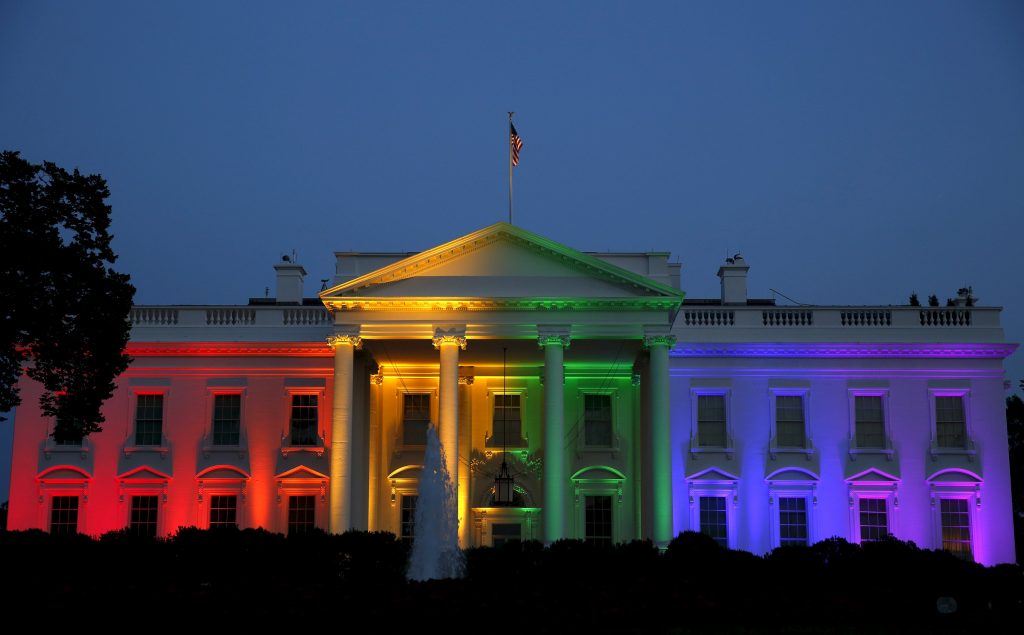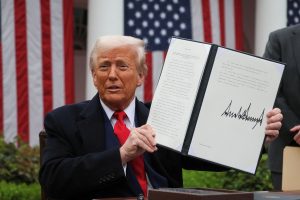President Trump dislikes brutalist architecture, the European-inspired trend that deposited concrete-clad federal buildings across the capital in the 1960s and ’70s. In his first week in office, he did something about it.
His memorandum declaring that new federal buildings should respect the nation’s “classical architectural heritage”—such as the column-and-pediment style of the White House—spoke to more than his personal aesthetics. It was one of several efforts by Trump to elevate the values of his MAGA movement by restoring a view of history, and of the symbols of American civic life, that he believes were distorted by liberals.
Trump last week decreed that the nation’s tallest mountain would revert to the name Mt. McKinley , honoring one of his favorite presidents, William McKinley , rather than the traditions of the Alaska Natives who have long called it Denali. He ordered the portrait of a disfavored military officer removed from a hall of honor, and he revived orders that U.S. embassies fly only the American flag, banning gay pride or similar banners.
Classical architecture, the Greek and Roman style that inspired early American leaders such as Thomas Jefferson , connects Americans to the ancient roots of democracy, Trump has argued, whereas modernist architecture pleases only the artistic elites.
“This is prosecuting the culture war on all different fronts,” said Peter Wehner , a critic of the president who served in the administrations of Ronald Reagan and both Bushes.
Many of the president’s early orders were part of his push to strip “woke” ideas and diversity programs from government, and they thrilled his supporters. “They think the woke movement was an attack on the culture and made us feel ashamed of our culture,” Wehner said. “This is a reassertion of the way things were.”

The White House is illuminated in rainbow colors after today’s historic Supreme Court ruling legalizing gay marriage in Washington June 26, 2015. REUTERS/Gary Cameron
TPX IMAGES OF THE DAY
Trump’s actions in his first week continued a battle from his first term against efforts to strip Confederate names from military bases and to protect Confederate statues in public squares. Trump in his first term also sharply criticized the 1619 Project, the set of New York Times essays that sought to recast the nation’s origin as the arrival of the first slave ship, calling that event, in a now-deleted phrase, the nation’s “true founding.” Trump created a group called the President’s 1776 Advisory Commission, which set the signing of the Declaration of Independence in 1776 as the nation’s founding moment and framed the quest for freedom as its true heritage.
The president will have a chance to shape views of the American story during the nation’s 250th birthday next year, which he has said should inspire a year-long celebration. In his speech last week at the World Economic Forum in Davos, he noted that by “a stroke of luck” he would be president during the birthday year.
Newt Gingrich , the former House speaker and Republican presidential candidate, said Trump was trying to elevate the cultural values he prizes after they were overtaken by the political left. The “one flag” policy at embassies “is a repudiation of the left’s efforts to make other flags equal to the American flag,” Gingrich said. Trump’s architecture memo emphasizes a continuity in style that is familiar from the White House, the U.S. Capitol and other landmarks of democracy, connecting Americans to their past and rejecting “random individualism” in government architecture.
Alaska’s two senators, and many Alaska residents, say the rightful name for the massive mountain in their state is Denali , a word the Koyukon Athabaskan natives have used for centuries that is often translated as “the Great One.”
Gingrich, by contrast, saw the decision as speaking to America’s aspirations. Trump’s kinship with McKinley amplifies his efforts to take control of Greenland and the Panama Canal and “is an effort to say, ‘We’re not static. We’re not declining. We’re not trapped in who we are but launched into who we could be.’ ” During McKinley’s presidency, the U.S. annexed Hawaii, while the Philippines and Guam became U.S. territories.
“Trump,” Gingrich said, “in a sense represents the reassertion of American history.”
At the Pentagon, the White House ordered the portrait of retired Gen. Mark Milley , Trump’s former chairman of the Joint Chiefs of Staff and longtime subject of his ire , to be removed from a wall where it had hung alongside portraits of other former joint chiefs.
“I guess he’s OK with rewriting history,” Sen. Tim Kaine (D., Va.) said of Trump, suggesting to reporters that removing the portrait conflicted with Trump’s claim that stripping Confederate names from U.S. military bases would “tamper with” history. Trump in 2020 vetoed a major defense policy bill because of the base-renaming requirement.
The battle from Trump’s first term over renaming military bases and other assets that honor the Confederacy is likely to resume.
Congress overrode Trump’s 2020 veto , even though Republicans at the time held a Senate majority. Eventually, nine bases and several ships were given new names. Fort Hood in Texas, named for a Confederate general, became Fort Cavazos, named for the Army’s first four-star Hispanic general. Fort Bragg in North Carolina, named for a Confederate officer, became Fort Liberty.
Trump as a candidate, and again last month, promised to restore the prior names, adding at a December speaking event, “We’re going to get them back. And woke has to stop.” He also promised to block the proposed name changes of 14 ships.
Pete Hegseth , Trump’s narrowly confirmed defense secretary , has also said the prior base names should be restored in honor of the people who served there. But the administration’s ability to do so may be constrained by legislation that said no new or existing military asset may be given a Confederacy-linked name.
The renaming process has been emotional, with many opponents saying their goal isn’t to honor the Confederacy but rather the service members who served over decades at the bases. “From these facilities, we have won two world wars,” Trump said in his message vetoing the defense policy bill. “I have been clear in my opposition to politically motivated attempts like this to wash away history.”
Ty Seidule , a retired U.S. Army brigadier general who served on the panel that Congress created to rename bases, said the Confederate names imply approval of the “lost cause”—the claim that Southern states rebelled from the Union not to preserve slavery but to preserve states’ rights.
“The values of the Confederacy—those are not our values,” said Seidule, a professor emeritus of history at West Point. “The greatest moment in U.S. Army history was freeing four million men, women and children from bondage, preserving democracy and saving the United States of America, and that’s what we should be honoring.”
Write to Aaron Zitner at aaron.zitner@wsj.com



